If you want to plant a hardy perennial in your garden that will bring you many years of beautiful blooms, you can consider Baptisia, often known as “false indigo” or “wild indigo.”
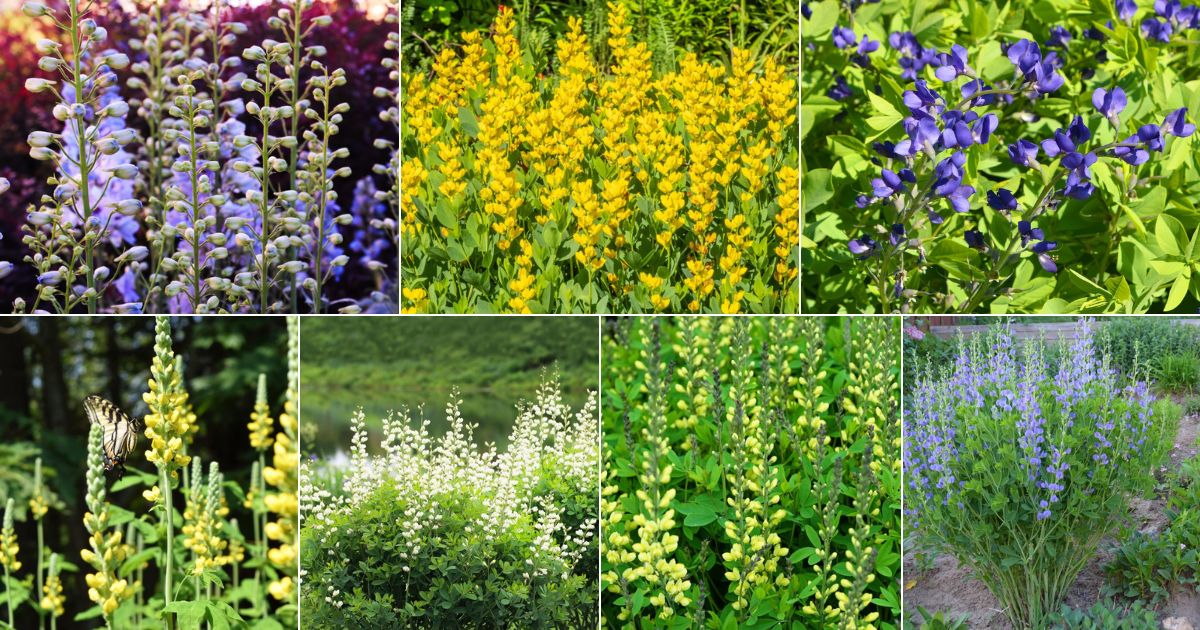
In our guide to Baptisia, we will go over what you need to know to grow and maintain wild indigo successfully. Jump to the section you want in the table of contents, or scroll down for the entire post.
Jump to:
- What Are Baptisia Plants?
- Baptisia Basics
- Where to Buy Baptisia
- Where Do Baptisia Plants Grow?
- Why Grow Baptisia Plants?
- Baptisia Landscaping Ideas
- Recommended Baptisia Varieties
- When Do Baptisia Plants Bloom?
- How Long Do Baptisia Plants Bloom?
- When to Plant Baptisia
- Ideal Growing Conditions for Baptisia
- How to Plant Baptisia
- How to Care for Baptisia
- How to Divide and Transplant Baptisia
- Recommended Planting Combinations for Baptisia
- Frequently Asked Questions About Growing Baptisia
What Are Baptisia Plants?
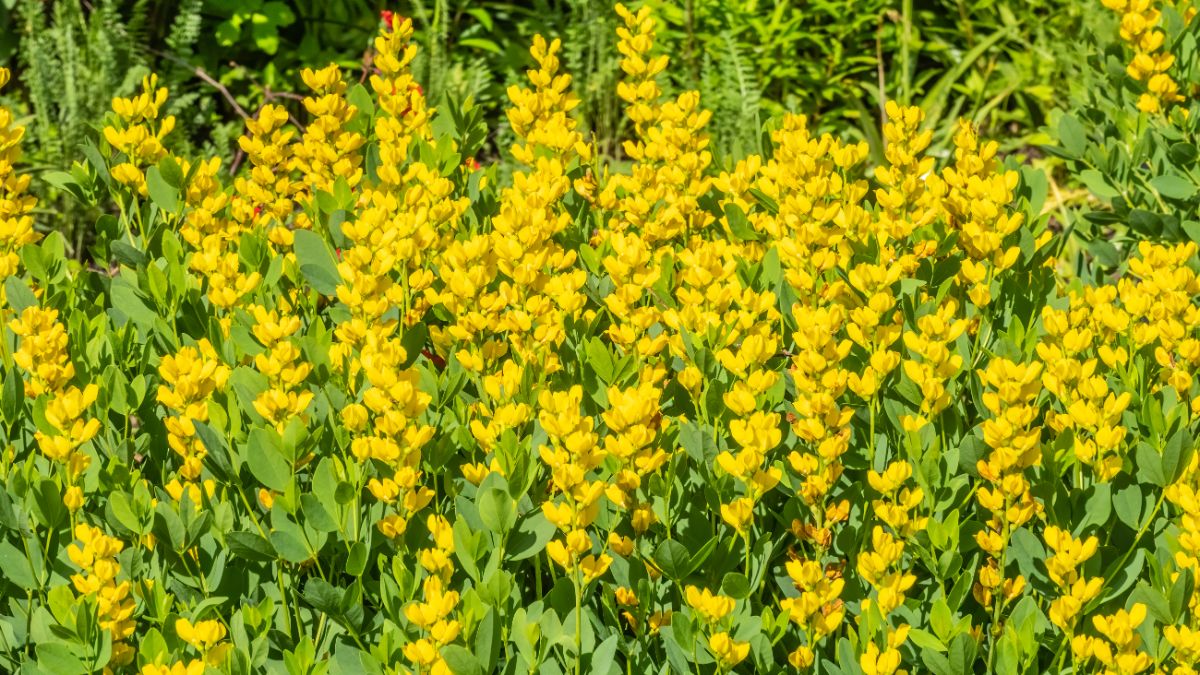
Baptisia is the name of a genus of herbaceous plants that are part of the legume family. While more than one species of Baptisia can be grown in your garden, B. australis is the most popular.
Indeed, it is that specific species of Baptisia that is known as “blue wild indigo” or “blue false indigo.”
Some other types of Baptisia plants have different common names, for example:
- Baptisia alba: White wild indigo
- Baptisia lecontei: Pineland wild indigo
- Baptisia calycosa: Florida wild indigo
- Baptisia sphaerocarpa: Yellow wild indigo, round wild indigo, or green wild indigo
Baptisia Basics
| Zones: | 4-9 |
| Blooming season: | Spring |
| Expected height: | 2-3 feet |
| Soil: | Rich, well-draining soil |
| Sun: | Full to partial |
Where to Buy Baptisia
Excited to plant Baptisia out in your garden? To shop for wild indigo now, click the link below. Enjoy your Baptisia flowers for many years to come!
Where Do Baptisia Plants Grow?
This genus of herbaceous perennials is native to North America, and typically grows in grasslands or wooded areas.
Since Baptisia can grow well in zones 4-9, it has been widely cultivated. Indeed, you can even find it growing in gardens in Europe. The Royal Horticultural Society in the UK has honored the plant with the Award of Garden Merit.
Why Grow Baptisia Plants?

Here are some reasons Baptisia is the perfect addition to your garden:
- This tough plant makes a lot of lists of easy perennial flowers to grow for beginners. The level of maintenance involved is next to none. In fact, we have seen multiple resources describe these beautiful, trouble-free plants as “ultimate” in this respect.
- Baptisia is drought tolerant. Requiring only an inch of water every other week once established, it is an excellent option if you live in a climate with dry conditions.
- The flower spikes come in a variety of colors. Whether you want blooms in yellow, blue, white or other hues, there is a false indigo plant out there to suit your garden.
- This plant can thrive in a variety of well-drained soil types. In fact, even if your soil quality is poor, false indigo can flourish and produce stunning blooms each year.
- Wild indigo may be good for other plants by enhancing the soil quality with its nitrogen-fixing roots. Plus, you will not need to fertilize it much if at all due to its nitrogen-fixing properties. That means that you can spare your garden ecology from unwanted chemicals.
- Pollinators love false indigo. Bees and butterflies will be excited to buzz and flit around your Baptisia plants each year. Some of the species of butterflies that enjoy these plants include Indigo Duskywings, Sulphurs and Eastern Tailed Blues.
- Add winter interest. The seedpods of wild indigo plants are enjoyable to look at during the winter. Plus, they can offer a food source for birds.
- The attractive foliage can fill out a large section of your landscape. Wild indigo plants can be pretty voluminous, which is a benefit if you need to fill out a large spot in your garden.
- Wild indigo is the perfect backdrop for other plants. Framed by the beautiful foliage behind and the flowers above, they will be a joy to behold.
- These blooms can make a beautiful additional to your flower arrangements.
We cannot emphasize enough that a few other perennials offer as many benefits with as little work as false indigo.
Baptisia Landscaping Ideas
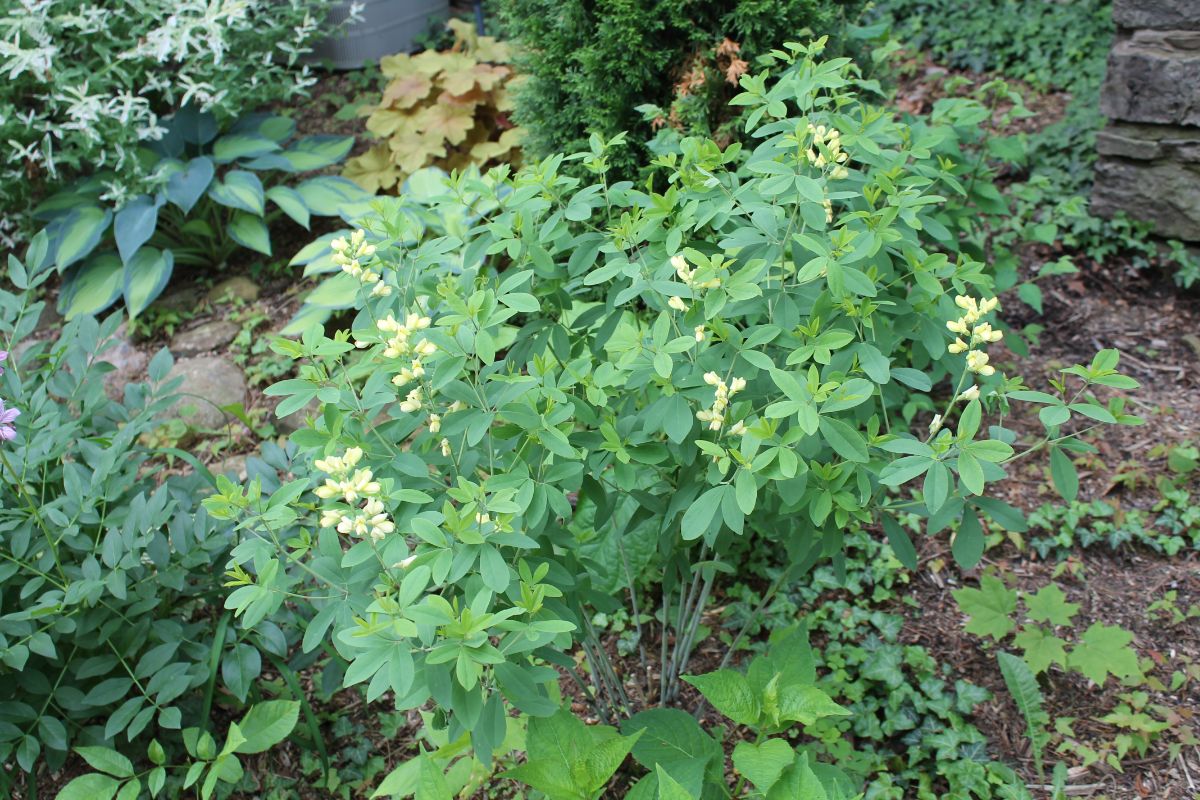
Here are a few ways you can use Baptisia in your garden:
- Cottage garden: With its voluminous foliage and blossoms, Baptisia is a suitable choice for a cottage garden.
- Backdrop for other plants: Plant some shorter perennials or annuals in front of your false indigo. The dark leaves of the Baptisia will make for a nice backdrop, and you will still be able to enjoy the Baptisia bloom spikes above.
- Around a bench: Baptisia is not quite tall enough to recommend as a general privacy screen. If you are standing, you can see over it pretty easily since it tends to max out at around 3 feet. But if you are seated, that is a different story. That is one reason it is popular to plant false indigo around a garden bench. Doing so can create an enclosed little nook with some privacy for those relaxing on the seat.
- Pollinator garden: Baptisia close to other pollinator plants can make for an attractive display that birds and insects will enjoy as much as you do.
- Native garden: Plant Baptisia alongside other hardy native perennials for a low-maintenance and ecologically-friendly garden.
Recommended Baptisia Varieties
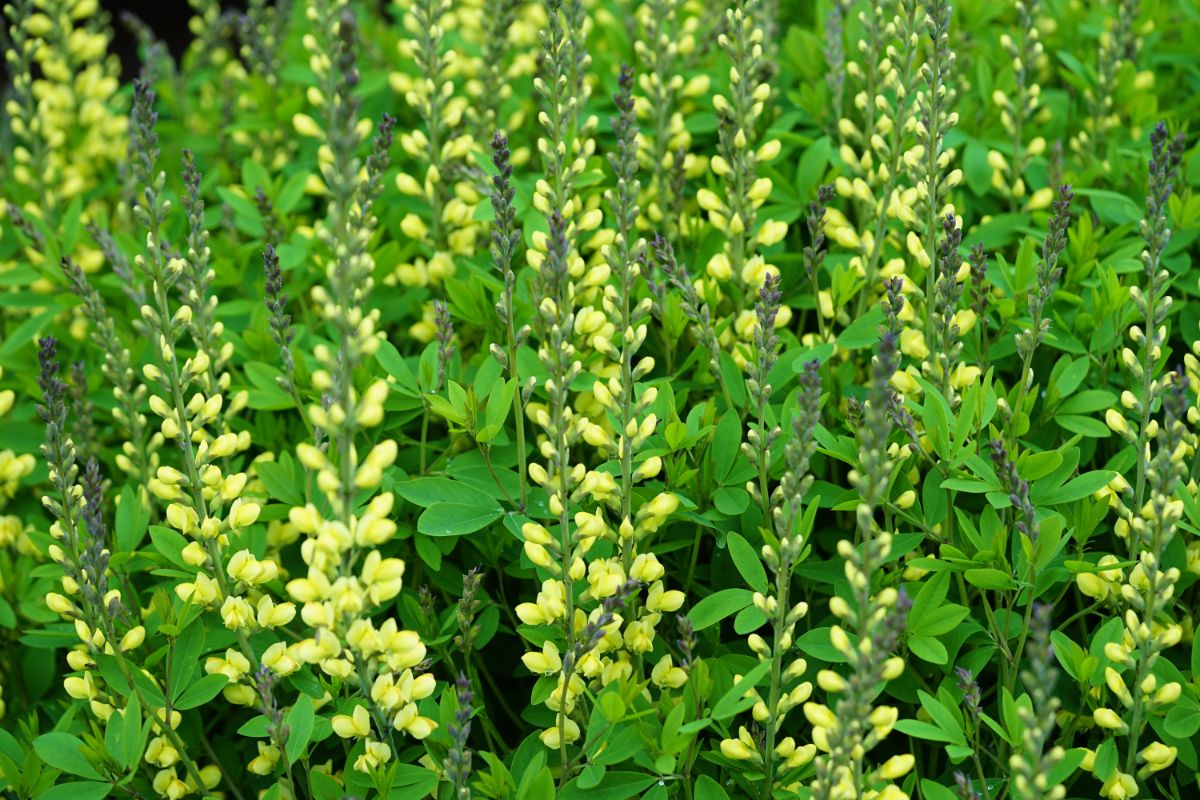
This perennial plant comes in a number of different varieties and cultivars with a range of flower colors. Here are some you will love:
- Anne: If you would like yellow flowers and a neat, elegant appearance, you cannot beat the mounding “Anne” cultivar of Baptisia. You might also want to get this cultivar if you are concerned about Baptisia spreading. It appears to be sterile.
- Wayne’s World: These tall plants feature white flowers. Since the stems have no leaves on the bottom, they have an elegant look. Be aware that it tends to grow outward more than “Ivory Towers,” and thus is a better choice if you have a larger area to fill out. But if you have a narrower spot, “Ivory Towers” may be more suitable.
- Ivory Towers: For white flowers, think about this cultivar. The spires of bloom produced by “Ivory Towers” will add their pure, crisp beauty to your garden for several weeks. Despite the fact that it is a pretty big plant, it tends to grow more upward than outward. Like “Anne,” “Ivory Towers” has a very graceful appearance.
- Screamin’ Yellow: For another Baptisia plant featuring a yellow color, look no further than this amusingly-named variety. It sports blue-green foliage and has sturdy, upright flower stems.
- Blue Towers: For deep blue-violent flowers, you might consider “Blue Towers.” The individual flowers are stunning, but be aware that the blue blossoms flower among dense bright-green foliage. As a result, you do not always get to enjoy an unobstructed view of the blooms.
- Lemon Meringue: The bold yellow blooms of “Lemon Meringue” will bring their vivid hues to your garden for around three weeks of the year in late May.
- Cherries Jubilee: One of the most unique cultivars of Baptisia is called “Cherries Jubilee.” This striking plant produces flower clusters that are yellow close to where they connect to the stems and read further out. The biocolor flowers seem almost to have a warm apricot glow from a distance.
- Dutch Chocolate: Dark maroon blossoms that look almost like gray flowers from a distance make “Dutch Chocolate” one of the more unusual types of Baptisia.
- Blueberry Sundae: The deep violet-purple flowers of this cultivar are almost blue, giving it its name. If you have been looking for relatively compact plants within the Baptisia genus, “Blueberry Sundae” may be perfect for your garden.
- Purple Smoke: Each lovely flower of this hybrid is a pale lavender color. The “Smoke” part of the name refers to the grayish hue of the flower stems.
- Vanilla Cream: You might have noticed by now that quite a few cultivars of this native plant have names involving desserts. These are all part of the same series, called “Decadence.” This cultivar includes felted gray-green leaves and spikes of cream colored blooms. With its compact size, you might be able to fit it into a space that other cultivars are too large for.
- Deluxe Pink Lemonade: This stunning cultivar will wow you with its soft gradient of flower colors from yellow to a pinkish purplish hue. The older flowers are the one with the pinkish color.
- Deluxe Pink Truffles: Similar to Pink Lemonade, this cultivar showcases two colors: pink and lavender. Once again, this is due to the change in hue that happens as the flowers age.
- Lunar Eclipse: This dramatically-named Baptisia plant features flowers that start out white, but then age to purple.
- Sunny Morning: If bold contrasts are what you are after, this cultivar with its dark stems and bold yellow flowers will delight you.
- Royal Purple: Quite a few Baptisia plants sport deep blue-violet flowers. If you are looking for a deep purple with a warmer hue, consider “Royal Purple.”
- Sandstorm: This type of false indigo has bicolor flowers with a mixture of yellow and purplish-pinkish hues.
When Do Baptisia Plants Bloom?
The bloom period for Baptisia plants can start as early as March and range into April or May.
How Long Do Baptisia Plants Bloom?
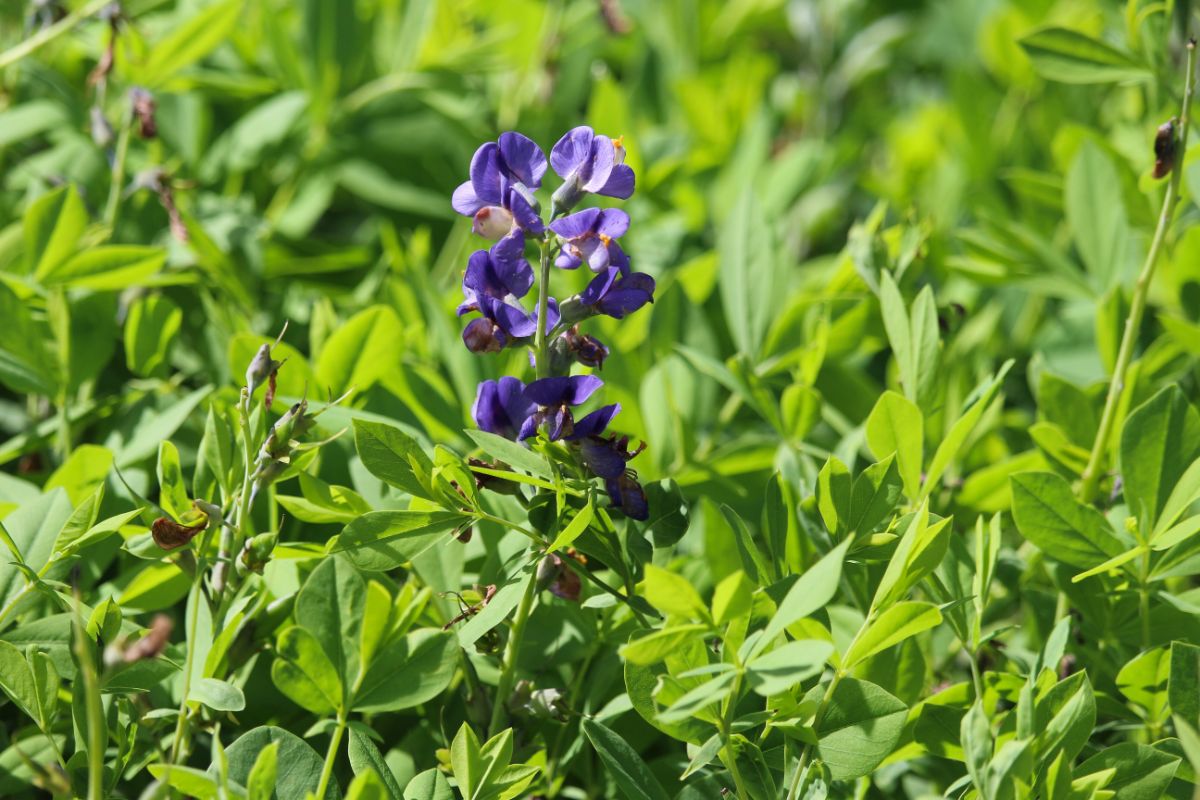
You can expect a bloom time of 3-6 weeks for your Baptisia flowers, depending on what type of Baptisia you plant and your growing conditions.
When to Plant Baptisia
You can either plant Baptisia in the spring or the fall.
Ideal Growing Conditions for Baptisia
To grow false indigo successfully, you need to know how much sun and water the plant needs as well as what type of soil is best for it.
It is very important to plant Baptisia in the right location! You are not going to want to move it later.
How Much Sun Do Baptisia Plants Need?

You can plant wild indigo in full sun or partial shade. At a minimum, it requires six hours of sun per day.
All things being equal, if you can choose between a spot with full sun and one with shade, you should generally go with the sunnier location.
Why? Because even though Baptisia can grow and flower in light shade, it usually will not produce as ample blooms and foliage if it is in the shade. They can take on a leggy appearance that is not as attractive.
What Type of Soil is Right for Baptisia?
Soil requirements for Baptisia are quite simple and straightforward. The soil should be rich and drain well if possible, and be either neutral or a bit acidic.
Soil too alkaline? Try adding a little sphagnum peat to improve the pH.
While richer soil is preferable, do not shy away from Baptisia if you have poor soil! The nitrogen-fixing roots allow this plant to thrive without as much nutrition in the soil.
Wild indigo plants do not like having wet feet, however, so you should not be growing them in soggy soil. Do not compromise on this point.
How Much Water Do Baptisia Plants Need?
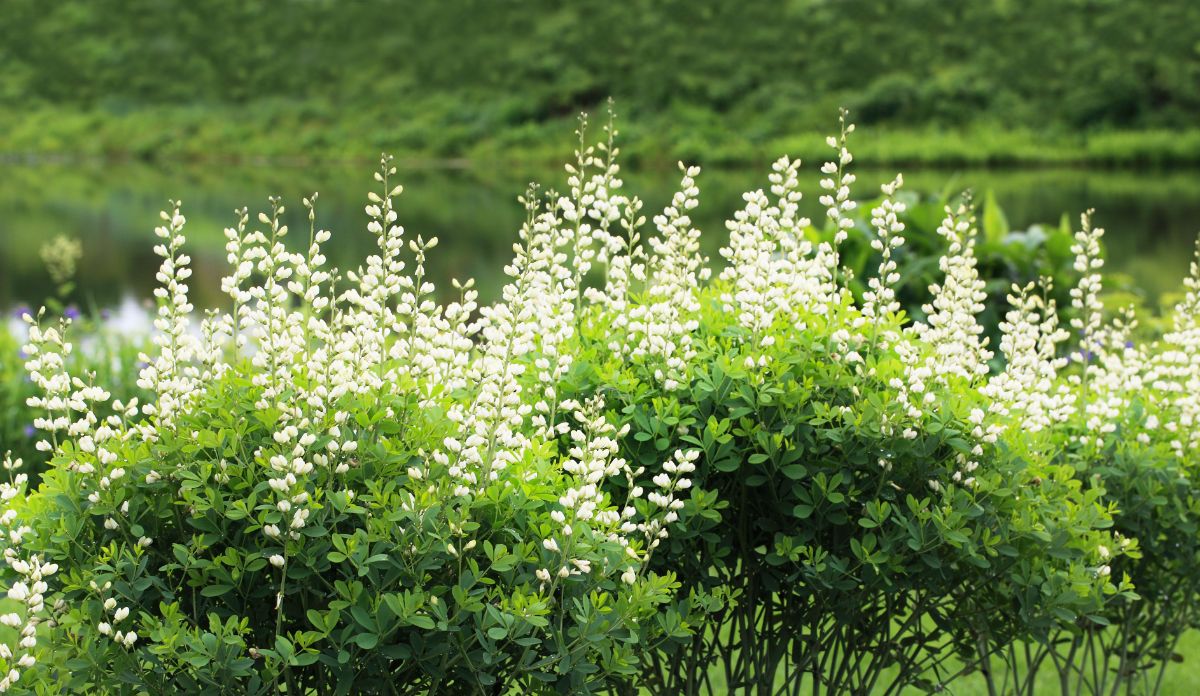
It takes a while for Baptisia to establish after you plant it. During that initial season, water it weekly with around 1 inch.
After the first season, you can water it about half that much. Give it the same amount, but do it every other week instead. Oftentimes, the precipitation you get will be enough to take care of the plant’s watering needs.
How to Plant Baptisia
There are two ways you can purchase Baptisia plants: as starter plants or seeds. Seeds can save you money.
For our directions below on ground planting, we will assume you have a nursery plant.
After that, we will talk about growing false indigo from seeds. Keep in mind that if you go the seed route, your plant may take several years to flower.
Can You Grow Baptisia in Containers?
First of all, let’s answer a question you might have, which is whether it is possible to plant false indigo in a pot or not.
Hypothetically, you could grow Baptisia in a very large pot. But should you? Probably not.
The reason has to do with the roots. They can dig very deep into the ground—we are talking as much as twelve feet.
Clearly, no container is going to provide you with that type of space. The Baptisia you try to grow in a pot is going to struggle. If it prevails, it may actually smash your pot to bits.
Save yourself time and trouble. Grow your Baptisia directly in the ground. If for whatever reason you cannot start it that way, choose a very big pot, and plan to transplant out into your garden beds as soon as is convenient.
Ground Planting
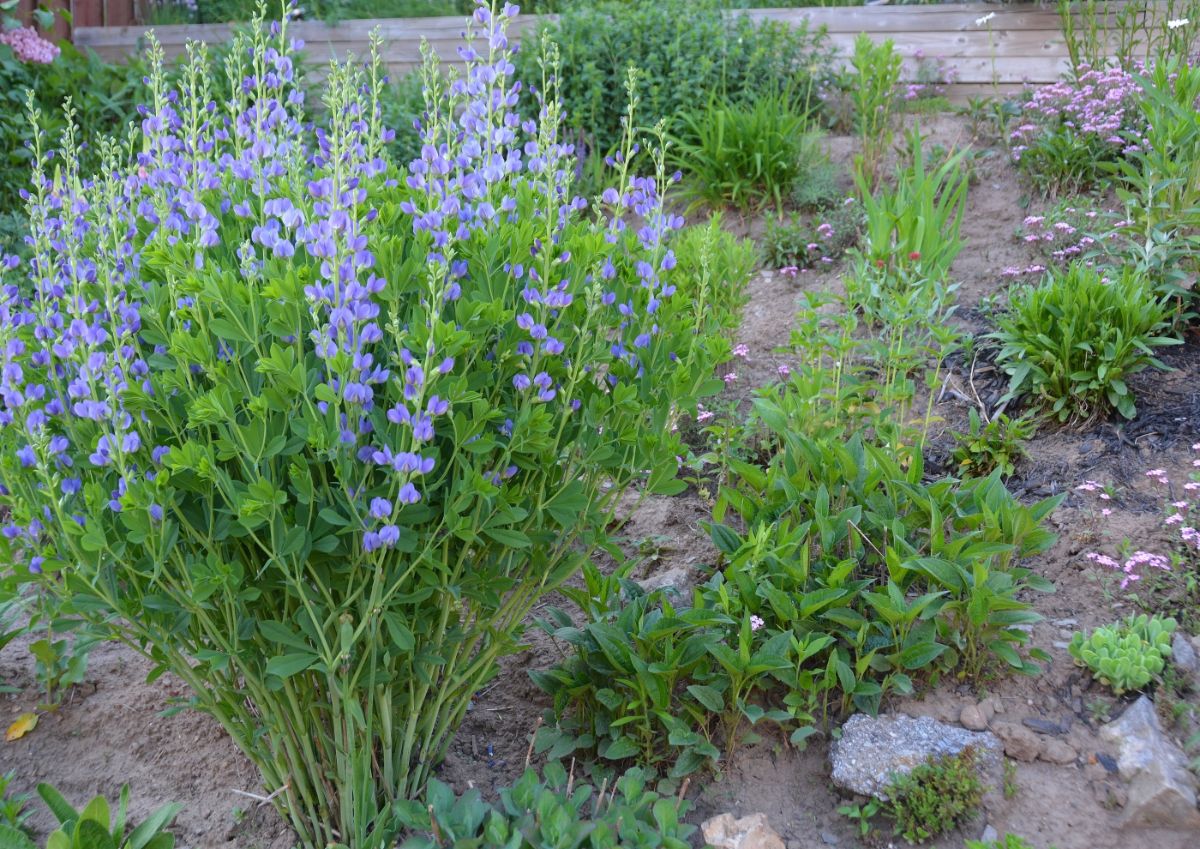
Now that you know why potted Baptisia is not a good idea, let’s go over the directions to plant false indigo in your garden beds.
- Choose a spot for your false indigo with plenty of sun and suitable soil.
Try and be absolutely sure you have found the ideal spot before you proceed with planting. You will have a difficult or impossible time relocating the plant later.
- Prepare the soil.
You can amend it with compost to provide the appropriate richness and drainage that this plant needs to thrive.
- Plant your false indigo nursery plants.
Dig holes and insert your false indigo plants, and then backfill the soil. If you are planting more than one, give each of them three to four feet of space. Ensure that other plants are not too close by either.
- Water well.
As your plant is establishing, it will require regular watering. After that, you can reduce the water you give.
Starting Baptisia from Seed
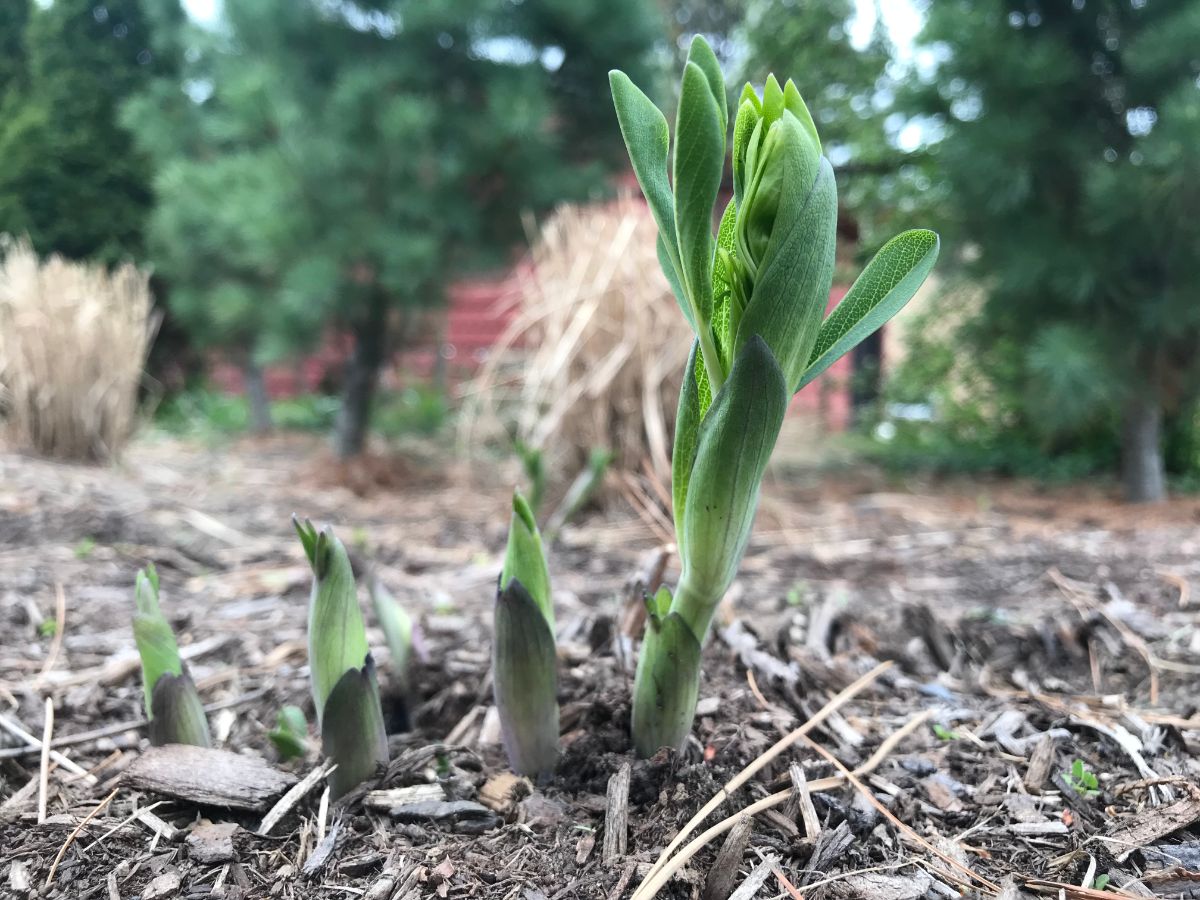
Whether or not germinating Baptisia seeds is a challenge seems to depend on who you ask. But if you want to give it a try, here is what to do:
- Obtain seeds. Either order them online, buy them from a local nursery, or get them from an existing plant.
If you use fresh seeds, make sure to look them over carefully. If you see any with little holes, you should get rid of them, as they have been infested with weevils.
If you are lucky enough to have obtained fresh seeds, all you need to do is sow them in your garden beds about ¼ inch down into the soil. Keep an eye on them, and you should see them germinate a couple weeks later.
If you do not have access to fresh seeds, proceed with the steps below.
- First, you will need to expose the seeds to cold temperatures for 6 to 12 weeks. You can do this in your refrigerator.
- Next, you must scarify the seeds. Otherwise, they will simply to be too hard to germinate. There are a number of methods you can use to do this. For a detailed guide, check this post at American Meadows.
- Following scarifying of your seeds, you must soak them for 24 hours in water.
- Fill pots with appropriate potting mix, and plant the seeds. Each should be covered by about a quarter inch of soil.
- Moisten the soil. Cover the pot so that the moisture does not dissipate too fast. Place it in a warm location.
Check on the soil as you wait for your seeds to germinate. If it starts drying out, moisten it again.
- Transplant the seedlings. You can do this once they reach 2 inches in height.
There are some alternate methods you can also use, so you might want to look up a few options and figure out which one will be most convenient.
Starting Baptisia from Cuttings
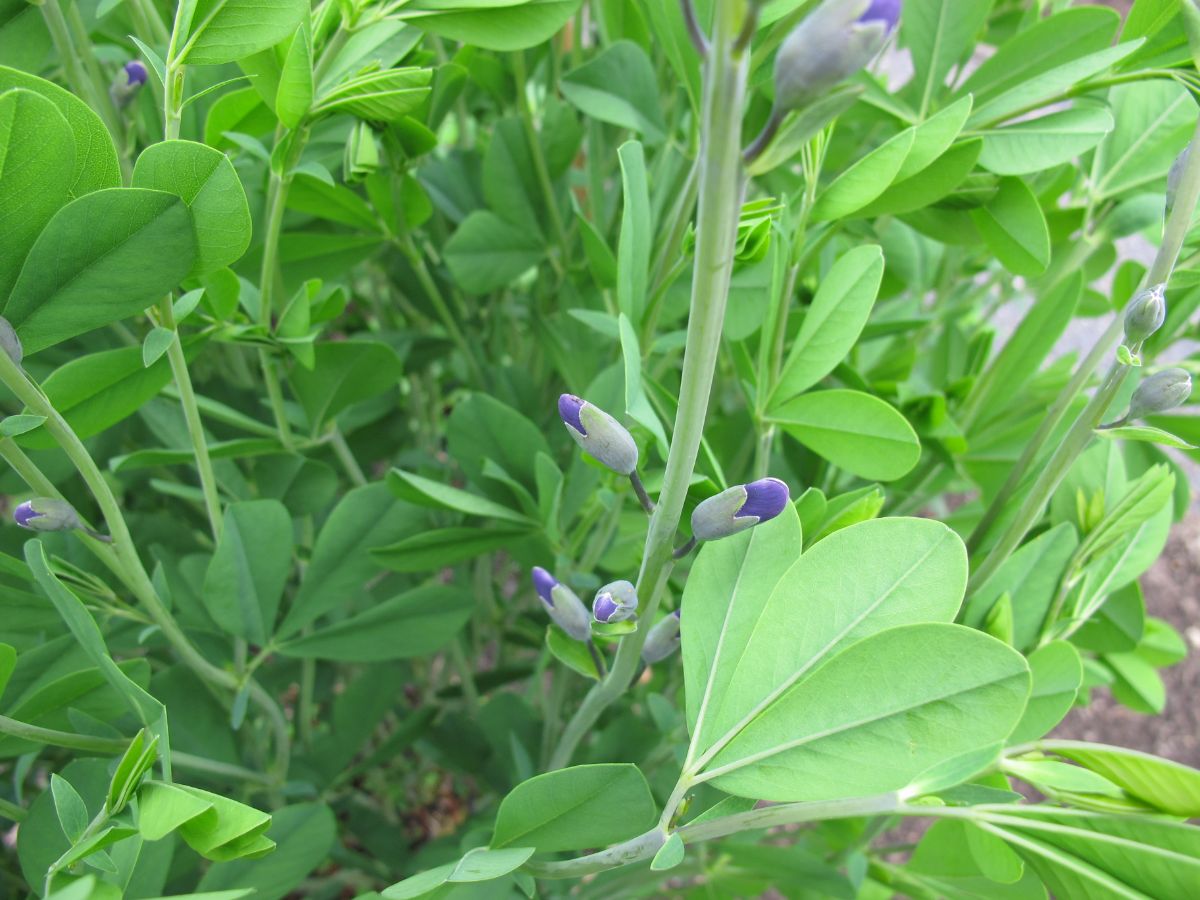
For those with access to existing false indigo plants, this is a popular method for propagation. It is not as involved as dealing with seeds.
- In early spring, take cuttings. Around 6 inches is a suitable length.
- Get rid of any leaves on the bottom halves of the cuttings.
- Dip the bottom tip of each cutting in rooting hormone.
- Fill a pot with soil.
- Moisten the soil, but allow it to drain.
- Push the cuttings down into the soil.
- Get a plastic bag and cover the pot with it, ensuring that the cuttings have sufficient room. This will lock in moisture.
- Wait for the cuttings to root. The process takes around two months, so you will need to keep moistening the soil. Fresh growth appearing indicates that roots have formed. Wait a little bit for the plants to develop some more, and then transplant them in your garden.
How to Care for Baptisia
Baptisia is ridiculously easy to grow and maintain, regardless of your skill level as a gardener. Here is what to know about fertilizing, mulching, staking and more.
How to Fertilize Baptisia
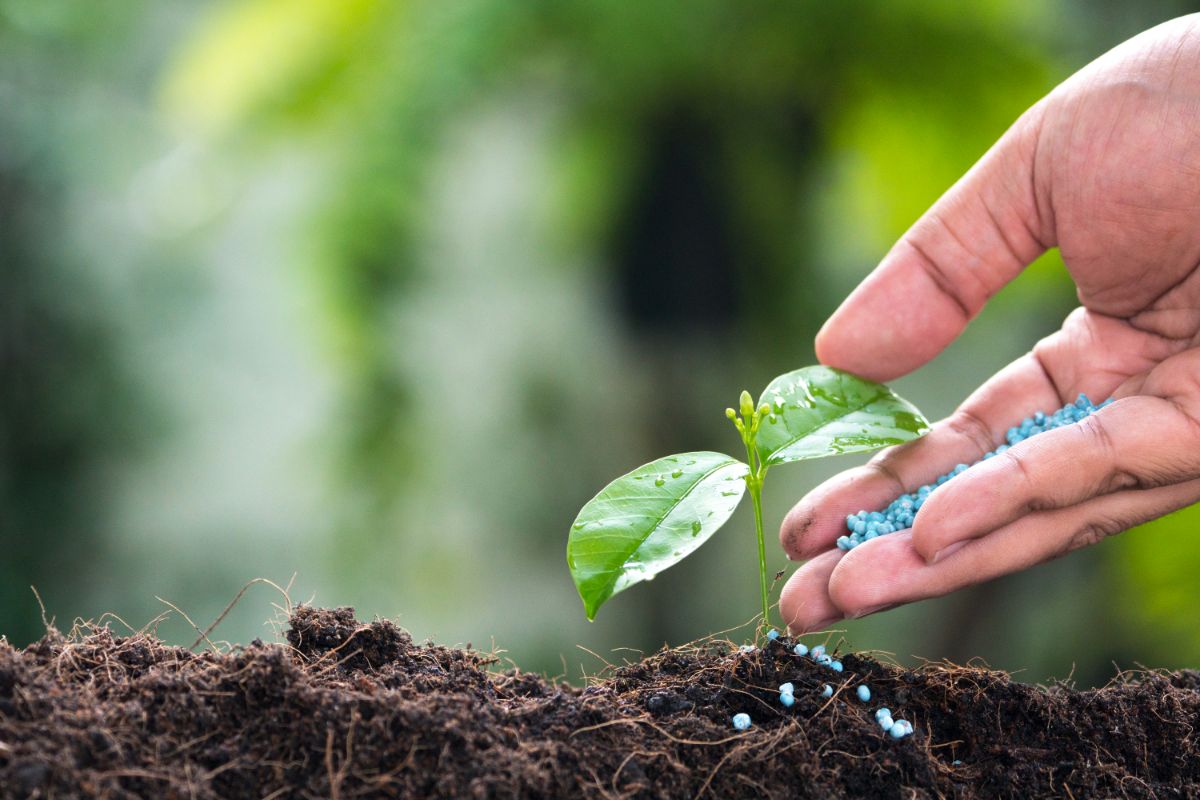
Baptisia is a nitrogen-fixing plant. That actually means that once this plant is established in your garden, you can go without fertilizer and it should do just fine.
Nonetheless, you can fertilize your false indigo if you wish. And actually, it can be smart to do so if it has been raining a lot. The water seeping into the soil leaches nitrogen from the plant’s roots, so it can sometimes use the supplemental nitrogen.
Another good time to fertilize Baptisia is right around when you see new growth each year. Try a slow-release fertilizer. This plant also appreciates compost.
How to Mulch Baptisia

Late in autumn, it is a good idea to mulch around your false indigo plants to protect the roots from low temperatures. Materials that work well for this include straw, compost, leaves or shredded bark. You will need around 6-8 inches.
How to Stake Baptisia
Staking Baptisia can sometimes be necessary as these plants are prone to flopping, especially when planted in partial shade.
Since Baptisia can grow to be quite large, you might require multiple stakes for a single clump. It works well to criss-cross them at angles to make a kind of grid. If you position them properly, they should scarcely be noticeable when your false indigo foliage is dense.
How to Prune Baptisia
Let’s talk about what you need to know about deadheading and trimming Baptisia plants.
Do You Deadhead Baptisia?
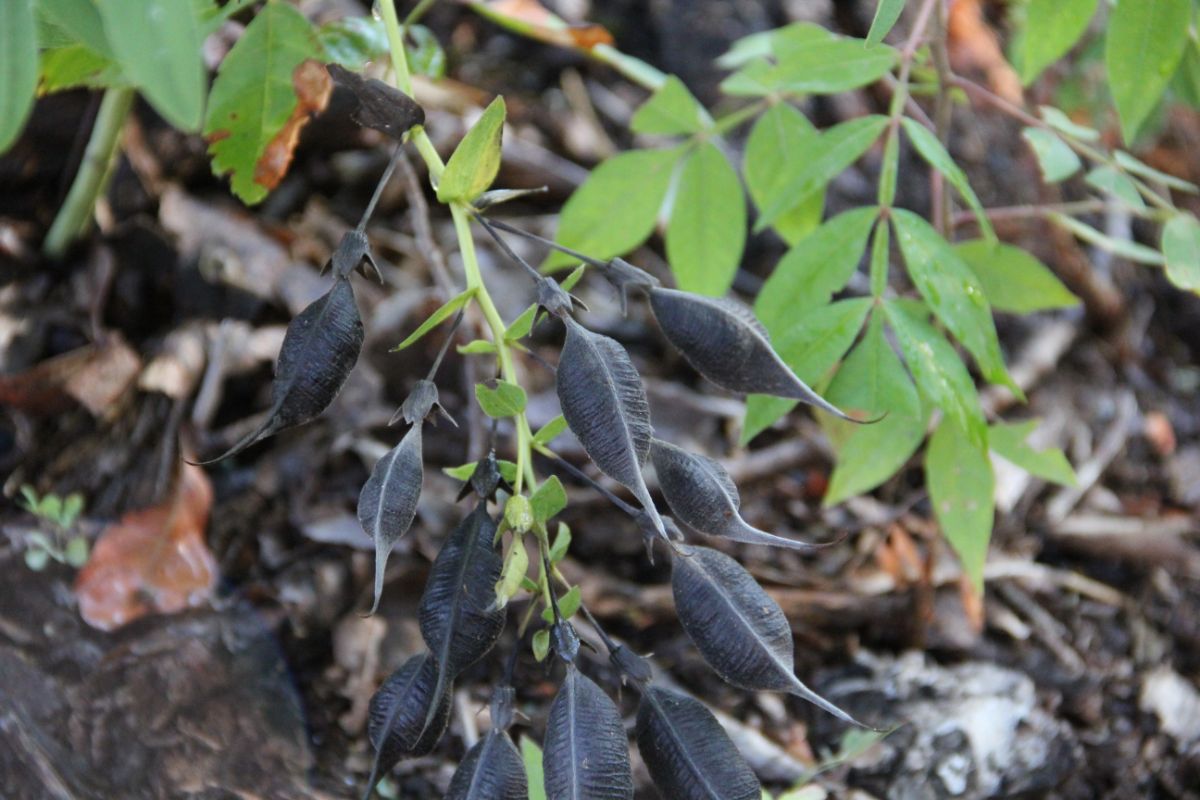
You can deadhead Baptisia to remove the seed pods (see below), but you can consider this activity part of your end-of-season trimming duties.
As far as we can tell, there are no indications that deadheading this plant can produce a second flush of blooms.
When to Cut Back Baptisia
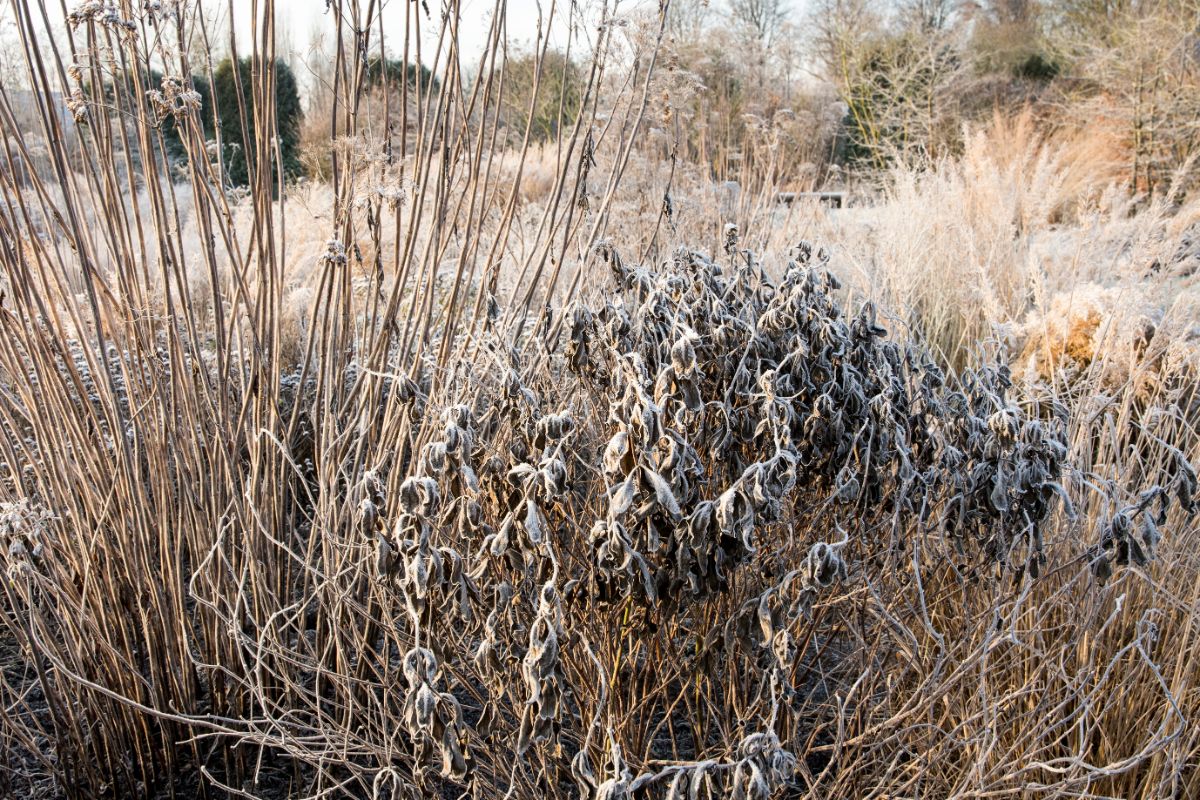
The right time to trim back you Baptisia for winter is when you see the foliage and stems blackening.
That said, you do not have to do this. And indeed, you may not even want to, depending on how you feel about seed pods.
Some people enjoy their appearance during winter when there is not much else to look at in the garden.
Of course, the plants can propagate themselves through their seeds, so that can be an issue if you are concerned about Baptisia spreading too much.
Also, the seed pods are heavy. As a result, they may not stand upright. If you find this aesthetically unpleasing or if you are concerned about the self-seeding, you should go ahead and cut them back.
Some people may also choose to prune Baptisia throughout the season to keep the plants from getting too tall or wide.
That said, wild indigo does not appreciate too much cutting back, and the more times you do it, the less happy the plant will be.
How to Divide and Transplant Baptisia
The best recommendation for dividing and transplanting false indigo is “don’t.” With roots digging way deep into the ground, it is not easy.
If you absolutely feel you must, however, it is possible.
- Either early in spring or right after flowering is done for the season, trim back your false indigo. Remove roughly half the plant.
- Dig holes for the new divisions.
- Excavate the Baptisia. And yes—it will feel like excavating. This is an involved process because the taproot is so hefty. Try and give it about half a foot of clearance all around as you dig down with the shovel.
Thankfully, you do not have to dig 10-12 feet down! But you do need to dig down around a foot.
Once you have made a circle around its perimeter, you can start cutting underneath. Yes, this may entail hacking right through some substantial roots. This is the trickiest part, as it can be hard to get a comfortable angle. You might even need to take a saw to them.
- Pull up the plant.
Now that the deep roots are no longer anchoring the false indigo, you can pull it up. If you are struggling to do this by hand, you can place something underneath it like a wood plank. Pushing down on one end will transfer force to help you raise the plant at the other.
- Make divisions.
This plant does not like being divided. But if you must, do it with a saw or axe. Get the loose soil out of the way first with a good shake.
6 inches in diameter is the minimum for a healthy division. If you cannot manage that, do not divide.
- Plant the divisions.
Finally, plant the divisions, backfill the soil, and water the Baptisia plants. They will likely need some extra water as they establish, but mind that you do not overdo it.
Now you can appreciate why we said the best way to transplant false indigo is “don’t.” You are committing to quite a laborious task if you proceed!
Are Baptisia Plants Vulnerable to Diseases or Pests?

According to PennState Extension, Baptisia plants may be prone to leaf spots, powdery mildew, stem rot, and rust. Be especially mindful when you are propagating using cuttings to avoid stem rot. As far as the rest go, usually it is sufficient to give your plants room to breathe and to avoid watering them with sprinklers.
There are some pests that may have a penchant for wild indigo. Most problematic among them tends to be weevils. You could also sometimes have problems involving slugs or snails.
Given other more palatable plants, deer and rabbits also will generally not consume Baptisia.
So, on the whole, this plant is not all that likely to struggle with pests or diseases, especially if you keep an eye on it and provide it with proper care.
Recommended Planting Combinations for Baptisia
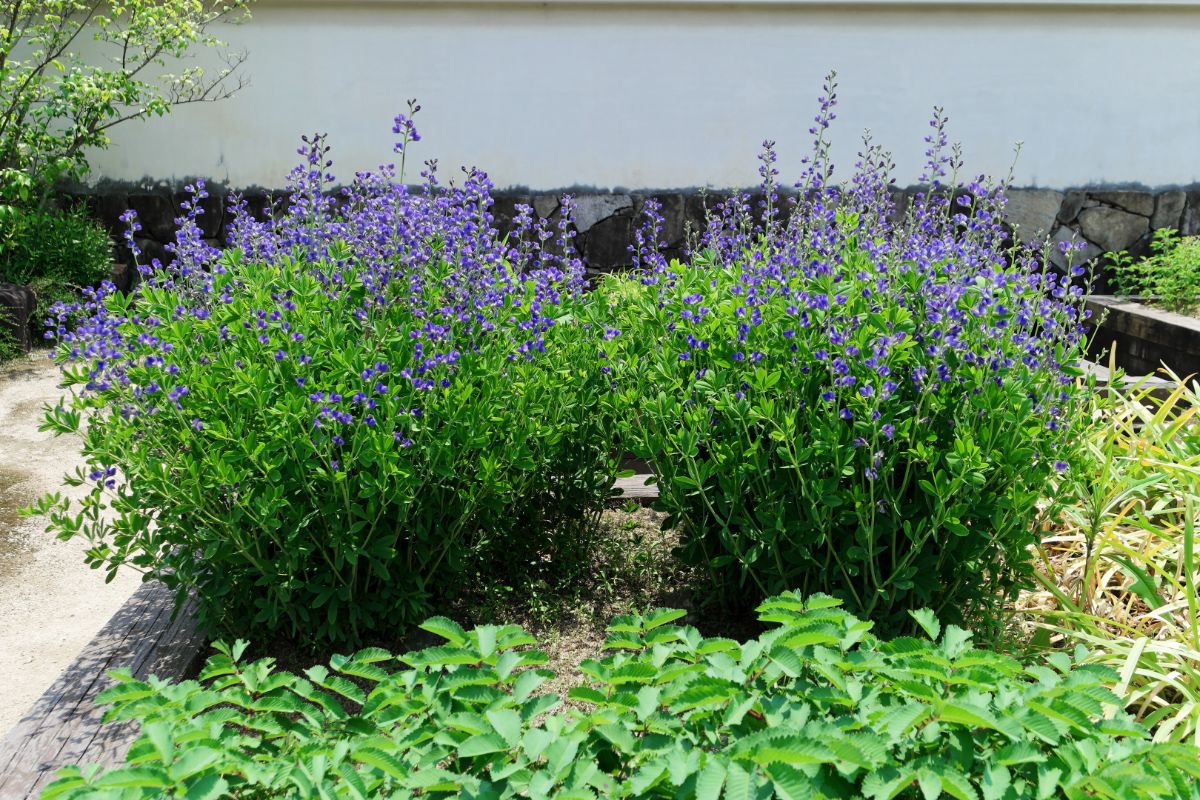
Baptisia makes a lovely companion to a wide range of plants. Here are some combinations that might appeal to you:
- Irises: These spring-blooming flowers can look gorgeous alongside wild indigo. Blue is the color you probably think of first with both of these flowers, so you could pair up blue irises with blue Baptisia if you want, or you can buy contrasting hues instead for a different look.
- Daffodils: These classic spring bloomers will look like splashes of sunshine in front of your Baptisia flowers. Plant yellow Baptisia for matching hues or blue Baptisia for a contrast.
- Astilbe: These flowers have a similar look to wild indigo, and tend to start blossoming late in spring. So, as your Baptisia blossoms start fading, these blooms can fill in.
- Geraniums: These popular perennials blossom throughout spring and continue into summer, making an excellent choice for planting near your wild indigo.
Frequently Asked Questions About Growing Baptisia
Weevils are the usual suspects when something is eating Baptisia. But it could also be caterpillars or some other insects. Slugs, snails, and occasionally mammals such as rabbits are also possibilities.
Baptisia plants are perennials. In fact, they are known to be quite hardy. So, you can depend on them to come back every year to grace your garden with their lovely blooms.
At a glance, it is easy to confuse Baptisia with asparagus. But this is not an edible plant.
Here is a paper in The Journal of Emergency Medicine that reports gastrointestinal symptoms, weakness, and “profound ataxia.” Usually the level of toxicity described for this plant is “low,” but clearly “profound” symptoms are something you want to avoid. So, make sure you do not ingest Baptisia.
Additionally, the entire plant is poisonous to animals as well. So, do not let your pets play around it unsupervised.
If your pet does ingest it, symptoms could include nausea, vomiting, and respiratory arrest. Call your vet immediately.
No, Baptisia is not invasive. But you should be aware before you plant it that 1-it can take up a lot of space, and 2-the roots dig way down in the soil. So, if you do not give it enough space, it could crowd out other plants.
The names “blue wild indigo” and “blue false indigo” for Baptisia australis refer not only to the color of the flowers, but also to one of their uses.
It is possible to make dye from Baptisia australis. Traditionally, this was a custom among the Cherokees. When Europeans moved to North America, they did the same thing.

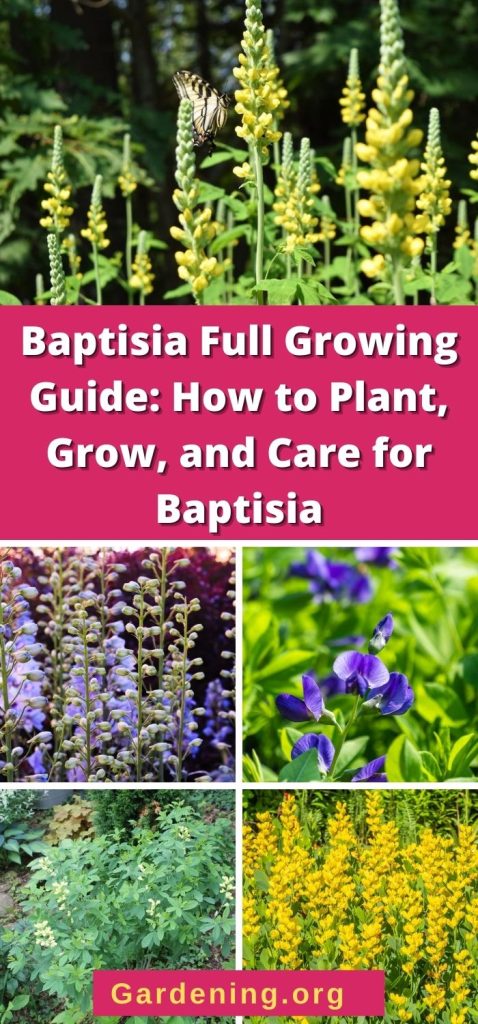

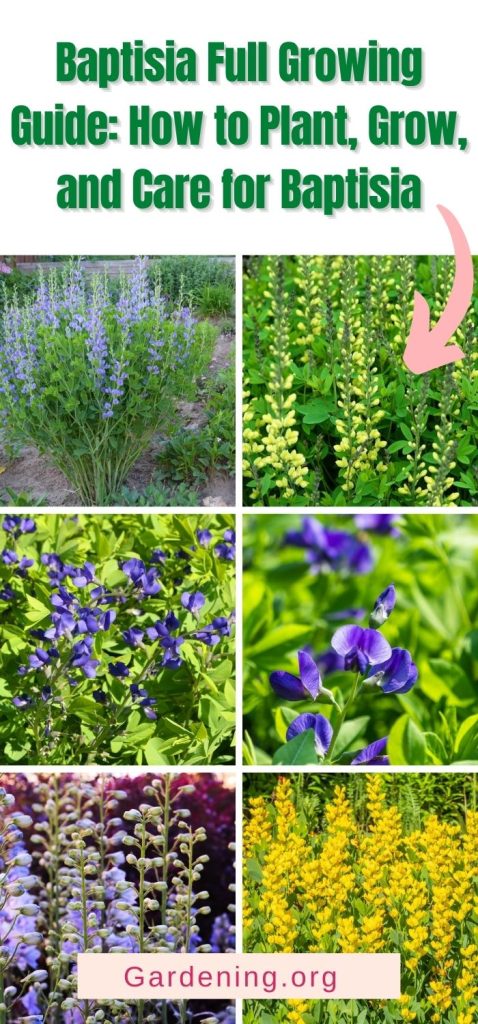
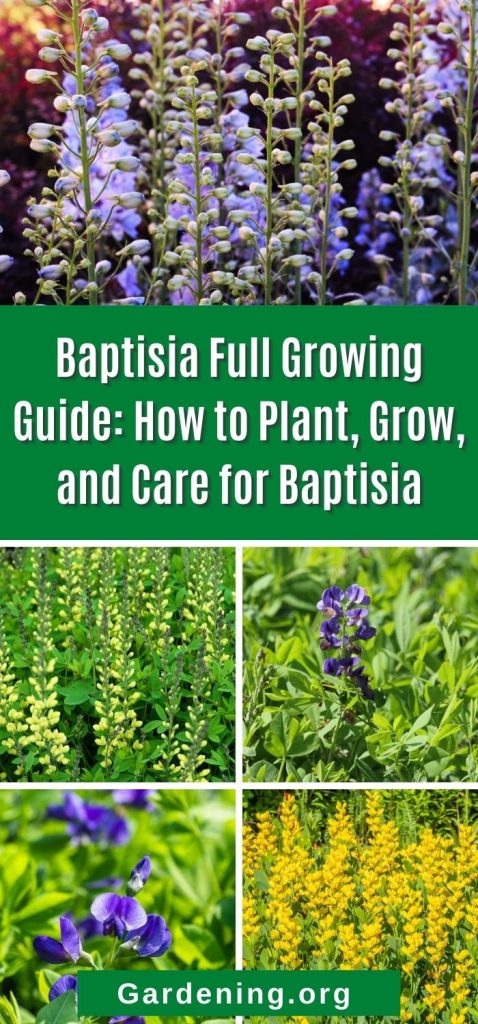




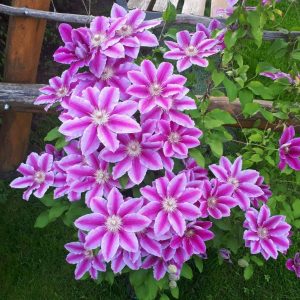
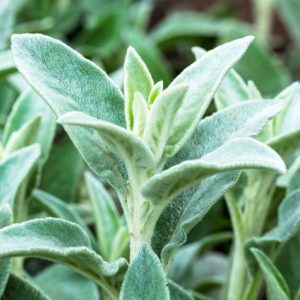
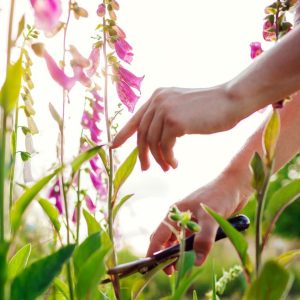
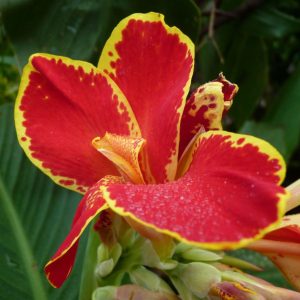
serdalia green
Thank you for this info on Baptistas. I have grown the australis for many years. I also have a yellow. I have a white one that is native here in West Georgia. It is low and spreds out with the bloom stalks hanging down, very pretty.
Mary Ward
Sounds beautiful!!